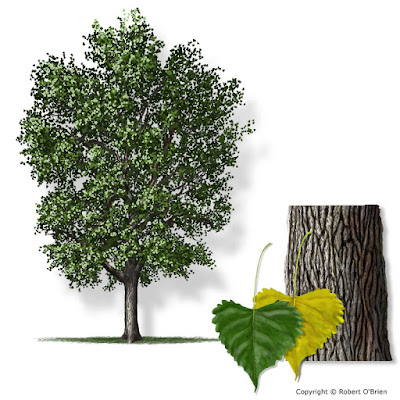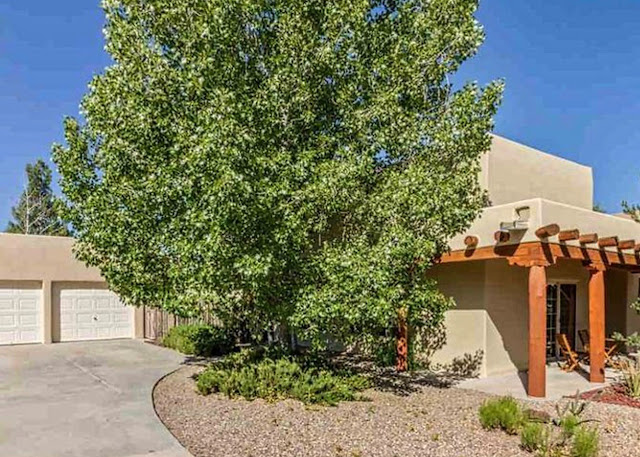The Alamo at Walking Rain
Los Alamos, New Mexico
The Alamo in Texas
Alamosa, Colorado
"Alamo" means cottonwood in Spanish and the ubiquitous native cottonwood tree provides place names for many locations in the west. In botanical Latin the western tree is Populous fremontii. There is an eastern cottonwood too, Populus deltoides. They are all really poplars.
A tall cottonwood dominates the corner of our house. In this grainy photo from the real estate listing, you can see how huge it is. It's the tallest, fullest, greenest, most massive tree in the entire neighborhood, actually.
We've since limbed it up a bit to get some light under for a garden by the house and to keep branches from drooping over the driveway, blocking the car.
Cottonwoods like riparian streamside environments, and in New Mexico they are called Rio Grande cottonwoods because they grow along the river's banks. But this Rio Grande cottonwood survives in a dry urban yard, next to a house and driveway, with no extra water. I'm surprised at how large it has gotten in these conditions.
It's not in great shape, however. There is a large swelling low on the trunk that looks bad and sprouts new leaves directly from deep furrows in the bark, as if the wound is constantly trying to heal itself. Since it seems to have lost a big limb where the wound is, the branching is now awkward.
The tree seems to be living two lives -- one half leafs out earlier than the other and in fall one half loses its leaves while the other half holds them. Fall color, usually bright golden yellow in cottonwoods, doesn't do much on this tree.
And the mess, ugh. There is snowy white cotton fluff in spring as the seeds disperse, and debris from constant twig drop all year long. In May I pull up sprouts from the surrounding gravel all the time, and when I turn around more sprouts jump up, poking right up through the landscape fabric under the gravel.
The sheer volume of leaves on this tree means we have monstrous piles of leaves everywhere when they drop -- all over my gardens and covering the gravel and driveway and permanently snagged in the junipers below.
But what glorious shade the alamo on Walking Rain provides in summer. It's on the east side of the house, in front of two large windows. The triangle shaped leaves are attached on flat stems in a way that makes the leaves flutter in a breeze. As they quake and tremble, the dining room dances with dappled shadows and sparkling sun all morning.
It's beautiful.
The Alamo in Texas
Alamosa, Colorado
"Alamo" means cottonwood in Spanish and the ubiquitous native cottonwood tree provides place names for many locations in the west. In botanical Latin the western tree is Populous fremontii. There is an eastern cottonwood too, Populus deltoides. They are all really poplars.
A tall cottonwood dominates the corner of our house. In this grainy photo from the real estate listing, you can see how huge it is. It's the tallest, fullest, greenest, most massive tree in the entire neighborhood, actually.
We've since limbed it up a bit to get some light under for a garden by the house and to keep branches from drooping over the driveway, blocking the car.
Cottonwoods like riparian streamside environments, and in New Mexico they are called Rio Grande cottonwoods because they grow along the river's banks. But this Rio Grande cottonwood survives in a dry urban yard, next to a house and driveway, with no extra water. I'm surprised at how large it has gotten in these conditions.
It's not in great shape, however. There is a large swelling low on the trunk that looks bad and sprouts new leaves directly from deep furrows in the bark, as if the wound is constantly trying to heal itself. Since it seems to have lost a big limb where the wound is, the branching is now awkward.
The tree seems to be living two lives -- one half leafs out earlier than the other and in fall one half loses its leaves while the other half holds them. Fall color, usually bright golden yellow in cottonwoods, doesn't do much on this tree.
And the mess, ugh. There is snowy white cotton fluff in spring as the seeds disperse, and debris from constant twig drop all year long. In May I pull up sprouts from the surrounding gravel all the time, and when I turn around more sprouts jump up, poking right up through the landscape fabric under the gravel.
The sheer volume of leaves on this tree means we have monstrous piles of leaves everywhere when they drop -- all over my gardens and covering the gravel and driveway and permanently snagged in the junipers below.
But what glorious shade the alamo on Walking Rain provides in summer. It's on the east side of the house, in front of two large windows. The triangle shaped leaves are attached on flat stems in a way that makes the leaves flutter in a breeze. As they quake and tremble, the dining room dances with dappled shadows and sparkling sun all morning.
It's beautiful.






Comments